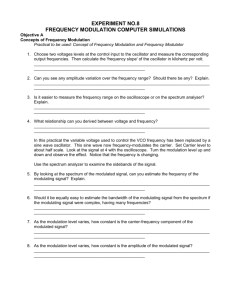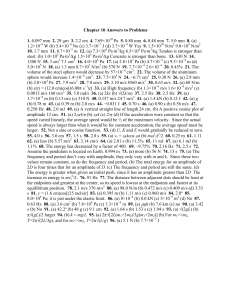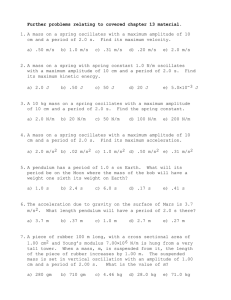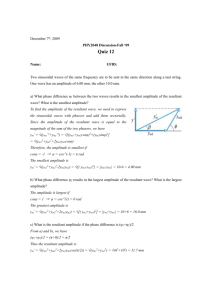Prof. J. B. Wiesner E. A.
advertisement
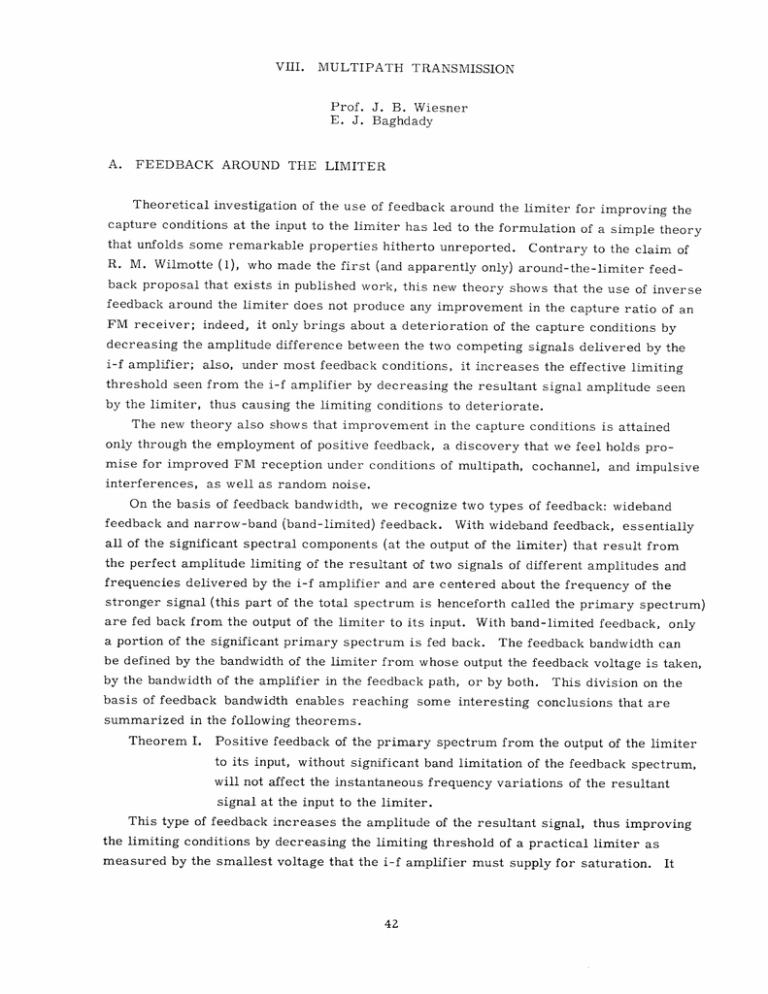
VIII. MULTIPATH TRANSMISSION Prof. J. B. Wiesner E. J. Baghdady A. FEEDBACK AROUND THE LIMITER Theoretical investigation of the use of feedback around the limiter for improving the capture conditions at the input to the limiter has led to the formulation of a simple theory that unfolds some remarkable properties hitherto unreported. Contrary to the claim of R. M. Wilmotte (1), who made the first (and apparently only) around-the-limiter feedback proposal that exists in published work, this new theory shows that the use of inverse feedback around the limiter does not produce any improvement in the capture ratio of an FM receiver; indeed, it only brings about a deterioration of the capture conditions by decreasing the amplitude difference between the two competing signals delivered by the i-f amplifier; also, under most feedback conditions, it increases the effective limiting threshold seen from the i-f amplifier by decreasing the resultant signal amplitude seen by the limiter, thus causing the limiting conditions to deteriorate. The new theory also shows that improvement in the capture conditions is attained only through the employment of positive feedback, a discovery that we feel holds promise for improved FM reception under conditions of multipath, cochannel, and impulsive interferences, as well as random noise. On the basis of feedback bandwidth, we recognize two types of feedback: wideband feedback and narrow-band (band-limited) feedback. With wideband feedback, essentially all of the significant spectral components (at the output of the limiter) that result from the perfect amplitude limiting of the resultant of two signals of different amplitudes and frequencies delivered by the i-f amplifier and are centered about the frequency of the stronger signal (this part of the total spectrum is henceforth called the primary spectrum) are fed back from the output of the limiter to its input. With band-limited feedback, only a portion of the significant primary spectrum is fed back. The feedback bandwidth can be defined by the bandwidth of the limiter from whose output the feedback voltage is taken, by the bandwidth of the amplifier in the feedback path, or by both. This division on the basis of feedback bandwidth enables reaching some interesting conclusions that are summarized in the following theorems. Theorem I. Positive feedback of the primary spectrum from the output of the limiter to its input, without significant band limitation of the feedback spectrum, will not affect the instantaneous frequency variations of the resultant signal at the input to the limiter. This type of feedback increases the amplitude of the resultant signal, thus improving the limiting conditions by decreasing the limiting threshold of a practical limiter as measured by the smallest voltage that the i-f amplifier must supply for saturation. It (VIII. MULTIPATH TRANSMISSION) POSITIVE FEEDBACK Fig. VIII-1. Resultant signal at the input to the limiter, showing the effect of positive versus inverse feedback under wideband feedback conditions. also smoothes out the instantaneous amplitude variations of the input signal, thus increasing the maximum permissible value of the time constant for limiters that have time constants. We depend, in this theorem, upon the reasonable assumption that delay around the loop is negligible. The validity of this assumption and matters relating to stability are discussed in a thesis (Sc. neering, M.I.T., May D.) to be submitted to the Department of Electrical Engi- 1956. Figure VIII-1 shows the loci traced over one period of the difference frequency r by the end point of the phasor that represents the resultant signal at the input to the limiter under conditions of no feedback (ORo), and of inverse, wideband feedback (OR ). of positive, wideband feedback (OR+), Under the condition of feedback that is illus- trated, 1-a < Ks < 1 + a, the instantaneous amplitude of the resultant signal contributes to the zero crossings of the resultant wave by going through zero twice in every difference-frequency cycle. Under other conditions of inverse feedback, the instantaneous frequency of the resultant signal with feedback will be the same as that in the absence of feedback, as long as the instantaneous amplitude does not contribute to the zero crossings of the resultant signal. Theorem II. Inverse feedback of the primary spectrum from the output of the limiter to its input, without significant band limitation of the feedback spectrum, does not affect the instantaneous frequency variations of the resultant signal at the input to the limiter, as long as the instantaneous amplitude does not contribute to the zero crossings of the resultant signal. In general, this type of feedback decreases the amplitude of the resultant signal with the result that the limiting conditions deteriorate because of the increased limiting threshold of a practical limiter. Moreover, it may sharpen the instantaneous amplitude variations of the input signal, thus decreasing the maximum permissible value of the time constant for limiters that have time constants. Under feedback conditions that enable the (VIII. MULTIPATH TRANSMISSION) instantaneous amplitude to go through zero (such as 1 - a4 K s 1 + a) in a difference- frequency cycle, an impulse of instantaneous frequency, of area 1r, time the resultant amplitude goes through zero. is introduced every We conclude, therefore, that wideband inverse feedback is generally undesirable and must be avoided in these applications. In the general case of wideband feedback at an angle 4 fb' we can show that if y(t) and 0 (t) are the instantaneous phase of the resultant signal at the input to the limiter with and without feedback, then a feedback steady state will be reached in which d dt2 dt if Ks sin sin fb sin rt dO +arK 2 2 dt (1 + 2a cos rt + a ) (1 + Za cos rt + a 2 - K sin b/2 fb fb < 1 - a. From this expression, it is seen that the maximum spike magnitude is not affected by the feedback, but the shape of the instantaneous-frequency spike train has been distorted from its original symmetry about rt = 0 and rt = 1r. When K sin fb does not obey the indicated restriction, the situation cannot be so simply described. Theorem III. Regardless of the feedback angle, wideband feedback around the limiter will not affect the instantaneous-frequency pattern produced by the presence of the weaker signal in a way that is favorable for improvement in the interference rejection conditions. When only a few of the significant components in the primary spectrum are fed back, we are dealing with narrow-band feedback. The following theorems apply to this type of feedback. OR E,/a aE OR E, s p+r p + e BW) t) - S IDEAL LIMITE R + FOLLOWEDBY eo(t) IDEAL FILTER - (a) Eour k- 0 ET E, (b) Fig. VIII-2. Block diagram of feedback scheme. (a) Elementary feedback scheme. (b) Ideal limiter characteristic (Eth can be assumed to be as close to zero as is convenient). (VIII. Theorem IV. When the feedback is MULTIPATH TRANSMISSION) taken from the output of one stage of ideal limiting to its input through a feedback bandwidth equal to one i-f bandwidth, then, under the most adverse interference conditions passed by the i-f amplifier, positive feedback will improve the capture conditions at the input to the limiter by: (a) increasing the difference in relative amplitude between the stronger and the weaker signals; (b) decreasing the limiting threshold of a practical limiter through an increase in the effective signal amplitude seen by this limiter; and (c) producing an automatic -background, noise- squelching effect with nonideal limiters when the input signal level is below the threshold value that is required to saturate the limiter. (Delay, stability, and oscillation are considered in detail in the thesis referred to above.) Theorem V. When the feedback is taken from the output of one stage of ideal limiting to its input through a feedback bandwidth equal to one i-f bandwidth, then, under the most adver'se interference conditions passed by the i-f amplifier, inverse feedback causes the capture conditions to deteriorate at the input to the limiter by: (a) decreasing the difference in relative amplitude between the stronger and the weaker signals; and (b) increasing the limiting threshold of a practical limiter through a decrease in the effective signal amplitude seen by this limiter. Inverse feedback around the limiter does not exhibit the background noise-squelching effect that is demonstrated with positive feedback. Figure VIII-2 is a block diagram of the feedback scheme. Two useful designations for the amplitudes of the signals delivered by the i-f amplifier are: signal at p rad/sec; aEs or Ew for the signal at p + r rad/sec. notation, we define a constant K s = kG/E s , Es or Ew/a for the Using the s-subscript where k is a constant of the limiter, and G is the transfer voltage ratio of the feedback network. Using the w-subscript notation, we define Kw = kG/Ew. In Fig. VIII-3, we present plots of aj, the ratio of weaker-to-stronger-signal amplitude seen at the input to the limiter under the feedback and interference conditions pertinent to Theorems IV and V, amplifier. Positive K s and K s values, to inverse feedback. against a, the corresponding ratio delivered by the i-f negative K s and K w Obviously, a value of at that is less than the corresponding w values apply to positive feedback; a indicates that the positive feedback makes the weaker signal have a smaller relative amplitude than it had before the application of the feedback (even though the absolute value of this signal is now higher than before). Values of a, that are greater than the corresponding a indicate that the inverse feedback brings the two signals closer together in relative amplitude; therefore, it becomes increasingly more difficult to separate them. I- K 4 -3 -2 I I-lA 0 [AA"I0I Fig. VIII-3. -, I (a ) 2 3 4 A Effect of band-limited feedback around one limiter upon the ratio of weaker-to-stronger-signal amplitude at the input to the limiter. (a) Curves of constant originally stronger signal amplitude, E . (b) and (c) Curves of constant originally weaker signal amplitude, E . w (VIII. MULTIPATH TRANSMISSION) In each case, the effect of the feedback on the weaker-to-stronger-signal amplitude ratio, as seen by the limiter, varies with the value of K s or Kw . For a given circuit with fixed design factors, this means that the effect of the feedback will be greater at the lower input signal levels. The dependence of the resultant aI upon the input signal level can be minimized in the over-all performance of a receiver to a point that approaches complete elimination by cascading a number of identical limiters, each with its own feedback, as is demonstrated in the thesis. Under positive feedback conditions, a curious phenomenon is placed in evidence in the plots of Fig. VIII-3. Figure VIII-3a indicates that for the larger K s values there is a significant crossover into regions in which a becomes greater than unity while a, remains less than one. This implies that, after the feedback steady state is established, the weaker of the two signals can increase in amplitude so that it becomes the stronger one without upsetting the capture of the other signal. If all other conditions to which the plots apply remain unaltered while these changes are taking place, the corresponding variation of a with a, as the latter increases beyond unity, can be traced on the pertinent K s curve. For a given K s value, which is fixed by the assumed constant value of the amplitude of the originally stronger signal, this phenomenon of persistent locking to the originally stronger signal endures until a reaches a certain critical value (which may be significantly greater than one) beyond which rapid deterioration sets in, and the signal that If the is now stronger at p + r takes over its legitimate control of the reception. originally stronger signal at p rad/sec decreases in amplitude while the signal at p + r rad/sec is of constant amplitude and all other interference conditions pertinent to the given plots remain unchanged (that is, the feedback spectrum does not change in a manner that would make these particular curves inapplicable) for the duration of the decrease in amplitude, then the corresponding variation of a 1 with a can be traced on the pertinent Kw curve in Figs. VIII-3b and c. The "inertial" or locking phenomenon also evident here is particularly important under conditions of multipath and impulsive interferences. Theorem VI. If the feedback is taken from the output of the second, third, or nth stage of ideal limiting to the input of the first (each stage, except possibly the (n-1) s t , having one i-f bandwidth) and the feedback bandwidth is equal in extent to one i-f bandwidth, then, under the most adverse interference conditions delivered by the i-f amplifier, the effect upon the capture performance, caused by an increase in the amplitude difference between the two signals with positive feedback and the decrease in amplitude difference with inverse feedback, becomes increasingly more pronounced with higher values of n. "1 (, -7o-4 Fig. VIII-4. -3 -2 Effect of band-limited feedback around two cascaded limiters upon the ratio of weaker-to-stronger-signal amplitude at the input to the first limiter. (a) Curves of constant originally stronger signal amplitude, E . (b) and (c) Curves of originally weaker signal amplitude, E . W (VIII. Corollary. MULTIPATH TRANSMISSION) The longer the chain of narrow-band limiters that is spanned by the feedback branch, the more insignificant the amplitude of the weaker signal relative to the stronger signal becomes with positive feedback; and the closer together in amplitude the two signals will be with inverse feedback, both signals being observed at the input to the first limiter in the chain. This theorem is illustrated in Fig. VIII-4, in which plots of aI versus a are shown for feedback from the output of the second limiter to the input of the first under the conditions specified in the theorem. These curves must be compared with those shown in Fig. VIII-3. Theorem VII. When the feedback is taken through a feedback bandwidth of one th i-f bandwidth, from the output of the n limiter in a chain to the input of the first limiter, the effect of the feedback upon the ratio of weaker-to-stronger-signal amplitude at the input to the first s limiter is greatest when each limiter, up to and including the (n-1) t, Theorem VIII. possesses its lowest permissible bandwidth value of one i-f bandwidth. When the feedback bandwidth is the only parameter subject to variation, the effect of the feedback is greatest when the feedback bandwidth takes on its lowest permissible value of one i-f bandwidth. The fundamental conclusions of Theorems IV, V, and VI have stood the test of preliminary experimentation with a conventional two-stage limiter and a simple feedback circuit design (2). The basic philosophy of the new theory suggests the possibility of many new schemes, some of which might replace the conventional limiter section; others could be introduced in the i-f amplifier itself in order to modify the character of the resultant signal for easier separation of the signals. This approach also provides a quick, simple method (almost by inspection) for reaching expressions that relate the ratio of the weaker-tostronger-signal amplitude at any point in the scheme to the ratio delivered by the i-f amplifier under the most adverse interference conditions. B. THE CONCEPT OF THE EQUIVALENT INTERFERENCE RATIO Frequently, under conditions of two-signal interference, it is convenient to specify the capture conditions at any point within the high-frequency section of the receiver by the ratio of weaker-to-stronger-signal amplitude at that point, provided that no nonlinear action intervenes to alter the original two-signal spectrum on its way to the chosen point. However, it often happens that at the input of the second, or later, limiter, or at the input of a limiter with feedback, the spectrum is changed by a combination of amplitude limiting and narrow-band filtering into a form that has several spectral components instead of the two that represented the original signals. If the capture (VIII. MULTIPATH TRANSMISSION) conditions at these points are investigated Ao A A S Sp +r - ' in order to determine the effect of any con- 1e HAS SANME stituent stage (or stages) of the receiver upon these conditions, an acceptable and p+r logical method of specification is called for. AS Fig. VIII-5. We find that these requirements are ade- Concept of the equivalent interference ratio. quately met by introducing a generalized concept of the interference ratio. Our concept of the equivalent interfer- ence ratio that corresponds to a given spectral configuration caused by the presence of two carriers of different frequency and amplitude within the i-f passband recognizes that the most important characteristics of the time function that describes the instantaneous-frequency deviation of the resultant of the given configuration from the frequency of the stronger signal delivered by the i-f amplifier are the magnitude of the maximum frequency deviation (or frequency spike) and the rate at which this spike recurs (that is, the difference frequency between the two input carriers). With reference to Fig. VIII-5, if the given configuration of sideband components arises with a value of difference frequency, r, and in turn gives rise to an instantaneous-frequency spike of normalized magnitude X = [Aw /r, then an equivalent frequency-spike magnitude, recurring every 2Tr/r seconds, will also be produced when all the sideband components that are considered are replaced by one component at p + r rad/sec whose amplitude is a e multiplied by the amplitude of the component at p rad/sec, where S= [A]/r = ae/(l - ae), whence a = X/(1 + ). We find that the concept of the equivalent interference ratio is very useful in obtaining close estimates of the capture improvement of a limiter with feedback, under feedback conditions that would ordinarily lead to prohibitively involved computation, and for describing the capture conditions at the input of each narrow-band limiter in a cascade of limiters of this kind when it is desirable to gauge the improvement in the conditions brought about by each stage. E. J. Baghdady References 1. R. M. Wilmotte, Proc. IRE 40, 34-36 (Jan. 1952). 2. A. W. Emmons, S. M. Thesis, Department of Electrical Engineering, M. I. T., Jan. 1956.
